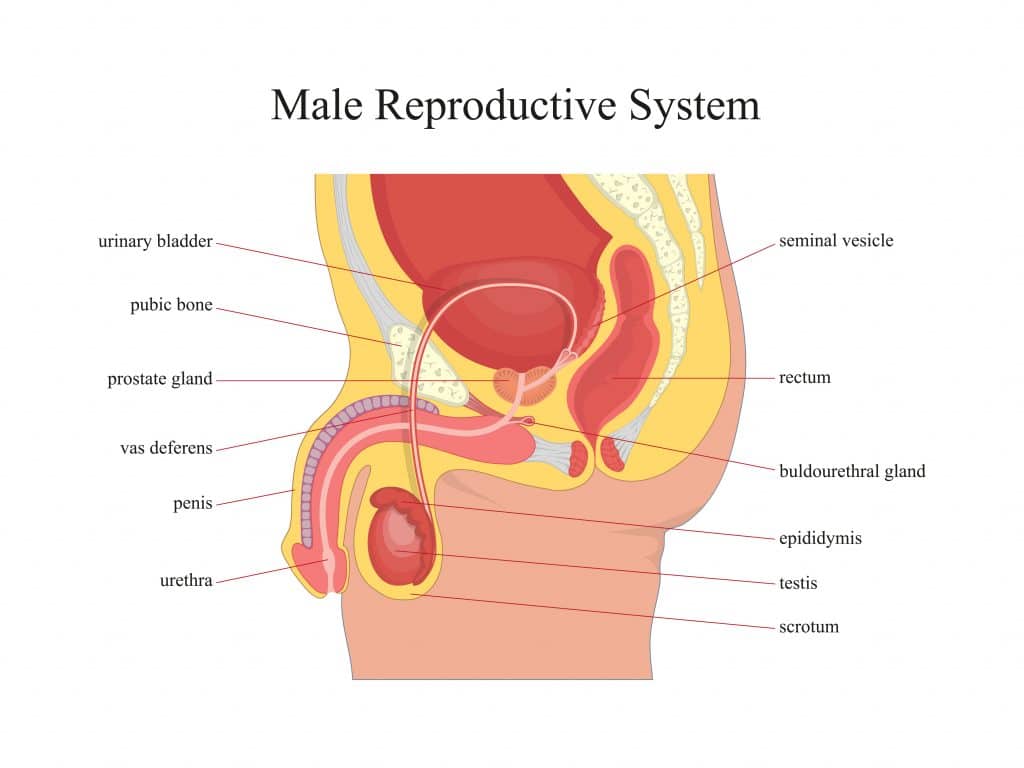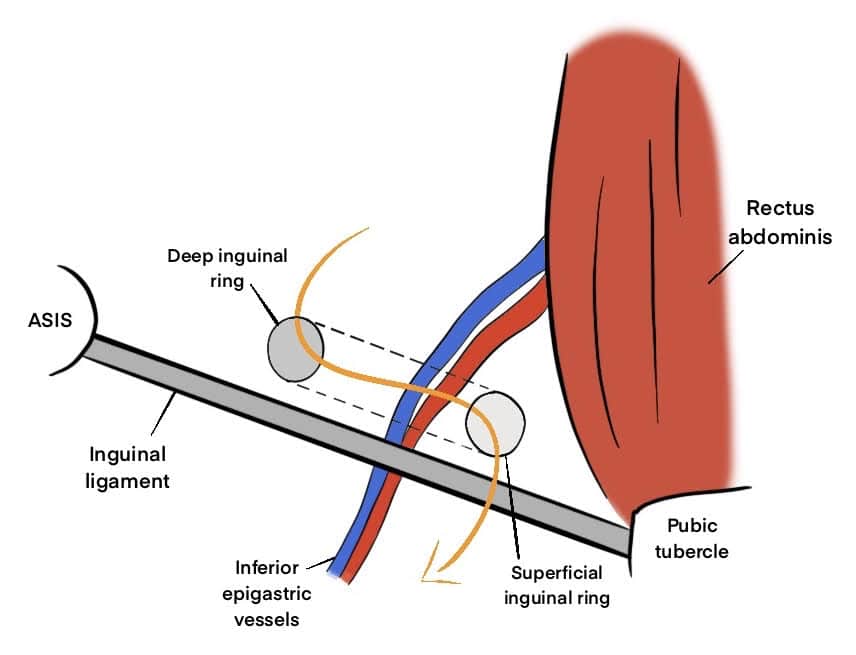Introduction
The definition of a hernia is the protrusion of viscus through a defect of the walls of its containing cavity. In the case of an inguinal hernia, the viscus is intra-abdominal contents (i.e. bowel), the containing cavity is the abdomen, and the protrusion is into the inguinal canal.
Pathophysiology
In an indirect inguinal hernia, which is the most common form in children, abdominal contents protrude through the deep inguinal ring into the inguinal canal, and through the superficial inguinal ring into the groin. This is due to incomplete closure of an outpouching of the peritoneum, called the the processus vaginalis, after the descent of testes in utero.
Direct inguinal hernias, commonly seen in adults, are a result of a weakness of the posterior wall of the inguinal canal. This is a section of the abdominal wall called Hesselbach’s triangle.

Figure 1: Diagram of the male reproductive system. Note the passage of the vas deferens (as part of the spermatic cord) from the abdomen to the testis through the inguinal canal. This is the path the hernia will follow into the scrotum.

Figure 2: The passage of the abdominal contents through the deep inguinal ring, into the inguinal canal, and through the superficial inguinal ring. ASIS: anterior inferior iliac spine.
Risk factors
- Prematurity
- Male sex (male:female ratio is approximately 8:1)
- Family history
Clinical features
Patients present with a groin swelling and likely, the presence of risk factors.
Associated symptoms such as nausea, vomiting, constipation, abdominal pain/discomfort could indicate obstruction (when bowel contents cannot pass) or strangulation (compression of the hernia has compromised the blood supply to the viscus, leading to the bowel becoming ischaemic – this is a surgical emergency).
On examination, there is an inguinal/inguino-scrotal mass that you cannot ‘get above’, is reducible when lying flat, does not transilluminate, and has a positive cough reflex. However, a hernia that has strangulated will present as an irreducible and tender tense lump, with the pain often being out of proportion to clinical signs; this may be accompanied with clinical features of bowel obstruction.
70% of inguinal hernias are right-sided, 20% are left-sided, and 10% are bilateral.
Differential diagnosis
- Hydrocele: possible to ‘get above’ a hydrocele, transilluminates, non-tender
- Varicocele: scrotal heaviness, non-tender, ‘bag-of-worms’ sensation on palpation
Investigations
Diagnosis of an inguinal hernia is by-and-large on a clinical basis; however, other investigations may be required if the diagnosis is uncertain, or more information is needed:
- Ultrasound scan
- CT scan (mainly used in patients with features of obstruction or strangulation, or when there is uncertainty in the diagnosis)
- MRI scan (rarely used)
Management
Definitive management is achieved through surgical repair of the hernia (herniotomy) which is performed on all full-term male infants with asymptomatic reducible inguinal hernias.
Emergency surgery may be needed in the case of an irreducible hernia, to prevent bowel and testicular ischaemia.
Complications
– Recurrence
– Strangulation
– Incarceration
– Bowel obstruction
References
| 1. Knott L. Inguinal Hernia. [Internet]. Patient.info. 2016 [cited 2 April 2021]. Available from: https://patient.info/doctor/inguinal-hernias |
| 2. Harding M. Lumps in the Groin and Scrotum. [Internet]. Patient.info. 2019 [cited 2 April 2021]. Available from: https://patient.info/doctor/lumps-in-the-groin-and-scrotum |
| 3. Kogan B, Erdem E. Inguinal hernia in adults – Symptoms, diagnosis and treatment [Internet]. BMJ Best Practice. 2021 [cited 2 April 2021]. Available from: https://bestpractice.bmj.com/topics/en-gb/723 |
